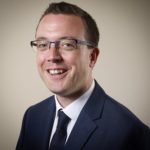

A&G is proud to announce that Oliver Cronk, the Chief Architect of Tanium, a Unified Endpoint Management and Security platform, will assist the magazine as a Contributing Editor.
Cronk works in the Office of the CISO (OCISO), working with customers and partners on how and where the power of Tanium can be leveraged within their architecture and environments. He is an IT architecture and DevOps leader with over 18 years of experience in a variety of IT roles across energy, government, telecommunications, banking, and professional services.
Cronk joined Tanium from Deloitte where he spent 3 years as the Chief Architect for Risk Advisory – responsible for driving innovation, digital transformation, and architecture of solutions for clients across a variety of risk areas. He has led on the architecture of on prem, private cloud, Azure, Office 365, and AWS initiatives and is AWS certified. Cronk leads on the Tanium Reference Architecture for IT Operations and Cyber capabilities.
He is a seasoned speaker (with IASA Global at its conferences and workshops, for example, which is how we got to know him) and advisor on Innovation, architecture, and DevOps. Cronk has a BSc (Hons) in Computer Science from the University of Essex and has been a BCS Chartered IT Professional since 2012.
In his role as Contributing Editor, he will write occasionally for the magazine as well as facilitate thought leadership from others. As an introduction to the readers, we recently asked him some questions.
Question: Tell us about yourself and your current role at Tanium?
Answer: I’m a technology strategy and architecture leader based in the UK. My role is as the Chief IT Architect for EMEA at Tanium. Prior to Tanium, I was the Chief Architect for Deloitte Risk Advisory in the UK (and before that in a range of developer and architect roles across different industries). Tanium is a tech scale-up that deals with the challenges of managing and securing endpoints across complex global customer organizations. I advise customers, partners, and prospects on ways to maximise the value of the Tanium platform within their architectures. I am also extremely fortunate in that I get to build a network and community of architects through a community called Architect Tomorrow that Tanium sponsors.
Q: When did you know you wanted to pursue a career in this field?
A: I’ve been into technology and computing from a very young age. My parents were teachers, and I spent a lot of time waiting for them after school – I used to fill that time learning about the early PCs of the 80s. This was a time when personal computing was just emerging – in the days of DOS and Windows 3.0 – and so I was lucky to be growing up at a time when technology was also growing up. I’ve seen the analogue world become increasingly digital and I continue to be blown away by how far technology and the internet has changed; and continues to change our lives. Given this focus growing up it was natural for me to work in technology – however the connection to the architect role didn’t come until later – when I realised my passion for helping others to understand and get the most of our technology. To a degree I was doing architecture all along – I’d always created diagrams, thought about the bigger picture of what I was doing and acted as a “tech translator” even when a software developer.
Q: Who has been your biggest mentor?
A: I have learned from a lot of people over the years including teachers, lecturers and colleagues, but the person that gave me the biggest head start was a very smart neighbour who worked in Internet Banking in the 90s. They introduced (and helped me master) the Linux operating system long before most had heard of it – this gave me a massive head start going into university and the world of work.
Q: Is there anything that keeps you up at night in terms of concerns or challenges?
A: While I’m usually super tired by the time my head hits my pillow, so it doesn’t affect my sleep there are some big challenges we face as a society that do concern me.
- Our lives feel increasingly artificial and disconnected from nature – the impact humanity is having on the planet is often hidden out of sight. We therefore don’t always see the damage we are causing. Out of sight out of mind until massive problems arise, we can’t avoid.
- While technology can be an amazing force for good – I am not sure we are getting the balance of innovation and controls right. If you think about the Sustainable Development Goals – not just linked to environmental sustainability but the other more human ones such as inequality – I fear technology may be driving further inequalities and problems. The digital divide is widening, and we need to be reskilling and educating people better on knowledge they need to thrive in an increasingly connected future world. This is particularly the case for cybersecurity – where cyber criminals are exploiting gaps in individual or corporate knowledge to wreak havoc.
I read a lot about this area – and a book Here be Dragons by Haggstom is well worth checking out. It’s kind of like a catalogue of dystopian futures (they perhaps you could expect to see as a plot of a sci-fi film!) but broken down and explored scientifically rather than hysterically or theatrically like Hollywood does!
Q: What are the biggest technology trends you expect to see in 2021?
A: 2020 acted as a massive catalyst in so many areas – particularly when it comes to remote working for industries that never allowed it before. It will be interesting to see how this matures in 2021 – in terms of the operating models, the technology but also addressing the risks and security challenges that were created in its wake.
I believe that 2021 will see the continuation of cloud migration and the final nails in the coffin for on premise (centric) technology and VPN (Virtual Private Networks) for the corporate PC to “phone home back to the office”. Organisations need the flexibility and agility that cloud offers them without the constraints of legacy on premise systems. But they will need to find a way to manage and secure the increased complexity hybrid and multi-cloud can bring. Smart architectures are part of the answer and I look forward to exploring this with architecture colleagues across the globe as part of the Architect Tomorrow community.
Q: What is your favourite thing to do in your free time?
A: Cycling – both road and off-road. Depending on the type of cycling it can:
- Reconnect me with nature, friends, and family
- Helps me recharge my mind and keep me balanced. Cycling is bit like my mediation – depending cycling like off-road requires you to be mindful – to switch off from the busy world and focus on the trail.
- Keep me fit and healthy!
